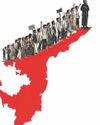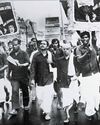Economic Modernist to Populist Personalism
Outlook
|March 11, 2024
The base for newly independent India’s development was set in the 1950s during a crisis period in the world

WHEN Jawaharlal Nehru became prime minister, there was euphoria across India on gaining independence, but it was also a time of crisis. A long and devastating colonial subjugation was ending. The world was emerging from the ravages of World War II. India was racked by poverty, illiteracy and ill-health. Access to roads and electricity was inadequate. The world witnessed a Cold War, militarisation and the formation of blocs.
A comparison with what has happened in Pakistan helps us to understand the difficulties faced by a newly independent nation. Both belong to the same stock, got independence simultaneously and had similar history and structures of governance. The two nations, which started with similar circums tances, have had divergent development paths, principally bec ause of the vision and the nature of their political leadership.

The leadership in India asserted its independence—it stayed out of the emerging great power blocs and provided the vision of the Non-Aligned Movement to the emerging free nations. In contrast, Pakistan joined the Western bloc, militarised and could not break the shackles of feudalism. It allowed the military to dominate the nation and went for theocracy and not secularism. Democracy did not have a chance to flourish because the political leadership was weak.
Historical narratives are always tricky since they require interpreting the past with present-day lenses. For instance, during the height of the Mughal rule, with Akbar at the helm, there was no electricity, no cars or airplanes or telephones.
Denne historien er fra March 11, 2024-utgaven av Outlook.
Abonner på Magzter GOLD for å få tilgang til tusenvis av kuraterte premiumhistorier og over 9000 magasiner og aviser.
Allerede abonnent? Logg på
FLERE HISTORIER FRA Outlook

Outlook
The Big Blind Spot
Caste boundaries still shape social relations in Tamil Nadu-a state long rooted in self-respect politics
8 mins
December 11, 2025

Outlook
Jat Yamla Pagla Deewana
Dharmendra's tenderness revealed itself without any threats to his masculinity. He adapted himself throughout his 65-year-long career as both a product and creature of the times he lived through
5 mins
December 11, 2025

Outlook
Fairytale of a Fallow Land
Hope Bihar can once again be that impossibly noisy village in Phanishwar Nath Renu's Parti Parikatha-divided, yes, but still capable of insisting that rights are not favours and development is more than a slogan shouted from a stage
14 mins
December 11, 2025

Outlook
The Lesser Daughters of the Goddess
The Dravidian movement waged an ideological war against the devadasi system. As former devadasis lead a new wave of resistance, the practice is quietly sustained by caste, poverty, superstition and inherited ritual
2 mins
December 11, 2025

Outlook
The Meaning of Mariadhai
After a hundred years, what has happened to the idea of self-respect in contemporary Tamil society?
5 mins
December 11, 2025

Outlook
When the State is the Killer
The war on drugs continues to be a war on the poor
5 mins
December 11, 2025

Outlook
We Are Intellectuals
A senior law officer argued in the Supreme Court that \"intellectuals\" could be more dangerous than \"ground-level terrorists\"
5 mins
December 11, 2025

Outlook
An Equal Stage
The Dravidian Movement used novels, plays, films and even politics to spread its ideology
12 mins
December 11, 2025

Outlook
The Dignity in Self-Respect
How Periyar and the Self-Respect Movement took shape in Tamil Nadu and why the state has done better than the rest of the country on many social, civil and public parameters
5 mins
December 11, 2025

Outlook
When Sukumaar Met Elakkiya
Self-respect marriage remains a force of socio-political change even a century later
7 mins
December 11, 2025
Listen
Translate
Change font size

